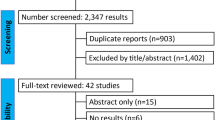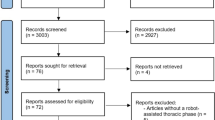Abstract
Background
Laparoscopic low anterior resection for rectal cancer is considered to be more technically demanding than laparoscopic colectomy. This study aimed to analyze the learning curve for laparoscopic low anterior resection and to identify the factors that influence this learning curve.
Methods
Data from 250 consecutive patients undergoing laparoscopic low anterior resection for rectal cancer, excluding patients with a combined resection such as cholecystectomy, hepatectomy, hysterectomy, or gastrectomy, between December 1996 and April 2010 were analyzed. For operative time, the learning curve was analyzed using the moving average method. The conversion rate and the postoperative complication rate were evaluated in five groups of up to 50 patients each based on the number of cases required for analysis of operative time. In addition, risk factors that influenced conversion to open surgery and postoperative complications were analyzed.
Results
The learning curve analysis for operative time using the moving average method showed stabilization at 50 cases. The conversion rate decreased significantly by group 4 (151–200 cases). The postoperative complication rate decreased significantly by group 5 (201–250 cases). The significant factors for conversion to open surgery were male sex (odds ratio [OR], 2.6094; 95% confidence interval [CI], 1.1–6.4) and T stage (OR, 2.4793; 95% CI, 1.1–5.8). For postoperative complications, male sex (OR, 3.8590; 95% CI, 1.9–3.8) was significant. In addition, the risk factors for anastomotic leakage were male sex (OR, 15.7659, 95% CI, 3.2–284.8) and multiple firing (2 or more cartridges for rectal transection) (OR, 3.0589; 95% CI, 1.1–9.5).
Conclusions
The risk factors affecting the learning curve for laparoscopic low anterior resection were T stage and male sex. In laparoscopic low anterior resection, rectal transection in particular can be technically difficult, and standardization for accurate performance of the same technique for expanded indications is very important.


Similar content being viewed by others
References
Jacobs M, Verdeja JC, Goldstein HS (1991) Minimally invasive colon resection (laparoscopic colectomy). Surg Laparosc Endosc 1:144–150
Milsom JW, Böhm B, Hammerhofer KA, Fazio V, Steiger E, Elson P (1998) A prospective, randomized trial comparing laparoscopic versus conventional techniques in colorectal cancer surgery: a preliminary report. J Am Coll Surg 137:46–57
Hasegawa H, Kabeshima Y, Watanabe M, Yamamoto S, Kitajima M (2003) Randomized controlled trial of laparoscopic versus open colectomy for advanced colorectal cancer. Surg Endosc 17:636–640
King PM, Blazeby JM, Ewings P, Franks PJ, Longman RJ, Kendrick AH, Kipling RM, Kennedy RH (2006) Randomized clinical trial comparing laparoscopic and open surgery for colorectal cancer within an enhanced recovery programme. Br J Surg 93:300–308
Clinical Outcomes of Surgical Therapy Study Group (2004) A comparison of laparoscopically assisted and open colectomy for colon cancer. N Engl J Med 350:2050–2059
Jayne DG, Guillou PJ, Thorpe H, Quirke P, Copeland J, Smith AM, Heath RM, Brown JM (2007) Randomized trial of laparoscopic-assisted resection of colorectal carcinoma: 3-year results of the UK MRC CLASICC Trial Group. J Clin Oncol 25:3061–3068
Fleshman J, Sargent DJ, Green E, Anvari M, Stryker SJ, Beart RW Jr, Hellinger M, Flanagan R Jr, Peters W, Nelson H (2007) Laparoscopic colectomy for cancer is not inferior to open surgery based on 5-year data from the COST Study Trial Group. Ann Surg 246:655–664
Jamali FR, Soweid AM, Dimassi H, Bailey C, Leroy J, Marescaux J (2008) Evaluating the degree of difficulty of laparoscopic colorectal surgery. Arch Surg 143:762–767
Schlachta CM, Mamazza J, Seshadri PA, Cadeddu M, Gregoire R, Poulin EC (2001) Defining a learning curve for laparoscopic colorectal resections. Dis Colon Rectum 44:217–222
Park IJ, Choi G-S, Lim K-H, Kang B-M, Jun S-H (2009) Multidimensional analysis of the learning curve for laparoscopic colorectal surgery: lessons from 1,000 cases of laparoscopic colorectal surgery. Surg Endosc 23:839–846
Li JCM, Hon SSF, Ng SSM, Lee JFY, Yiu RYC, Leung KL (2009) The learning curve for laparoscopic colectomy: experience of a surgical fellow in an university colorectal unit. Surg Endosc 23:1603–1608
Choi DH, Jeong WK, Lim SW, Chung TS, Park JI, Lim SB, Choi HS, Nam BH, Chang HJ, Jeong SY (2008) Learning curves for laparoscopic sigmoidectomy used to manage curable sigmoid colon cancer: single-institute, three-surgeon experience. Surg Endosc. doi:10.1007/s00464-008-9753-y
Dinçler S, Koller MT, Steurer J, Bachmann LM, Christen D, Buchmann P (2003) Multidimensional analysis of learning curves in laparoscopic sigmoid resection: eight-year results. Dis Colon Rectum 46:1371–1379
Tekkis PP, Senagore AJ, Delaney CP, Fazio VW (2005) Evaluation of the learning curve in laparoscopic colorectal surgery: comparison of right-sided and left-sided resections. Ann Surg 242:83–91
Diggle P (1990) Time series: a biostatistical introduction. Oxford University Press, London
CR JSC (1997) Japanese classification of colorectal carcinoma by Japanese Society for Cancer of the Colon and Rectum. Kanehara & Co Ltd, Tokyo
Chen W, Sailhamer E, Berger DL, Rattner DW (2007) Operative time is a poor surrogate for the learning curve in laparoscopic colorectal surgery. Surg Endosc 21:238–243
Wishner JD, Baker JW Jr, Hoffman GC, Hubbard GW II, Gould RJ, Wohlgemuth SD, Ruffin WK, Melick CF (1995) Laparoscopic-assisted colectomy: the learning curve. Surg Endosc 9:1179–1183
Agachan F, Joo JS, Weiss EG, Wexner SD (1996) Intraoperative laparoscopic complications: are we getting better? Dis Colon Rectum 39:S14–S19
Reissman P, Cohen S, Weiss EG, Wexner SD (1996) Laparoscopic colorectal surgery: ascending the learning curve. World J Surg 20:277–282
Marush F, Gastinger I, Schneider C, Scheidbach H, Konradt J, Bruch H-P, Köhler L, Bärlehner E, Köckerling F, Laparoscopic Colorectal Surgery Study Group (LCSSG) (2001) Experience as a factor influencing the indications for laparoscopic colorectal surgery and the results. Surg Endosc 15:116–120
Ito M, Sugito M, Kobayashi A, Nishizawa Y, Tsunoda Y, Saito N (2009) Influence of learning curve on short-term results after laparoscopic resection for rectal cancer. Surg Endosc 23:403–408
Laurent C, Leblanc F, Gineste C, Saric J, Rullier E (2007) Laparoscopic approach in surgical treatment of rectal cancer. Br J Surg 94:1555–1561
Kuroyanagi H, Oya M, Ueno M, Fujimoto Y, Yamaguchi T, Muto T (2008) Standardized technique of laparoscopic intracorporeal rectal transection and anastomosis for low anterior resection. Surg Endosc 22:557–561
Kuroyanagi H, Akiyoshi T, Oya M, Fujimoto Y, Ueno M, Yamaguchi T, Muto T (2009) Laparoscopic-assisted anterior resection with double-stapling technique anastomosis: safe and feasible for lower rectal cancer? Surg Endosc 23:2197–2202
Scheidbach H, Schneider C, Konradt J, Bärlehner E, Köhler L, Wittekind Ch, Köckerling F (2002) Laparoscopic abdominoperineal resection and anterior resection with curative intent for carcinoma of rectum. Surg Endosc 16:7–13
Morino M, Allaix ME, Giraudo G, Corno F, Garrone C (2005) Laparoscopic versus open surgery for extraperitoneal rectal cancer. Surg Endosc 19:1460–1467
Disclosures
Hajime Kayano, Junji Okuda, Keitaro Tanaka, Keisaku Kondo, and Nobuhiko Tanigawa have no conflicts of interest or financial ties to disclose.
Author information
Authors and Affiliations
Corresponding author
Rights and permissions
About this article
Cite this article
Kayano, H., Okuda, J., Tanaka, K. et al. Evaluation of the learning curve in laparoscopic low anterior resection for rectal cancer. Surg Endosc 25, 2972–2979 (2011). https://doi.org/10.1007/s00464-011-1655-8
Received:
Accepted:
Published:
Issue Date:
DOI: https://doi.org/10.1007/s00464-011-1655-8




